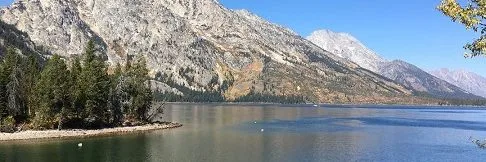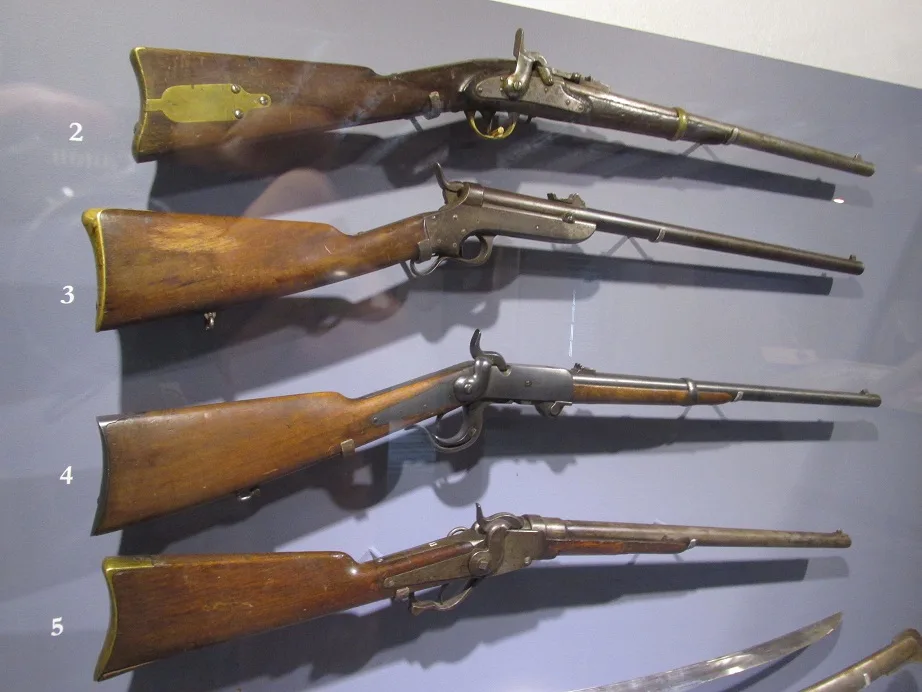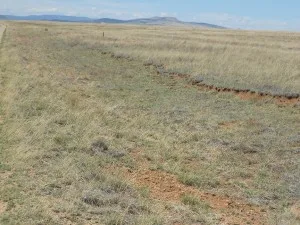Trips Into History had the opportunity to visit historic sites of the old west that today display some amazing collections of old carbines and other firearms that saw action during the frontier days.
Thank you for reading this post, don't forget to subscribe!Below is a collection of old carbines popular with the cavalry that are on display at Fort Garland in southern Colorado. Like many of the old frontier forts, Fort Garland was established to protect settlers and foster the growth of towns and commerce.
The four rifles displayed here are the Merrill Carbine 1861, the Sharps and Hankins Model 1862, the Burnside Carbine 4th Model 1864 and the Model 1858 Starr Carbine. Some of these carbines may be more familiar to you than others.
The Merrill Carbine Type 1
The top carbine shown in the photo, the Merrill Carbine, manufactured in Baltimore Maryland, was said to be not too popular with the troops. The carbines were originally designed for sport use and didn’t adapt well to the rigors of cavalry use. Sights and hammers were also said to break off during rugged use.
The Merrill 1st Type .54 caliber was first issued to the army in 1861 and it’s estimated that just under 15,000 were produced. These carbines saw action during the war in both the east and the west. Additional Merrill models were introduced during the Civil War. The carbine had a breech system with a long lever released by a spring latch. It was percussion primed using a paper cartridge. Features with this firearm included a brass buttplate, brass patch box, brass trigger guard, single brass band, and a saddle riding ring.
The Sharps and Hankins Model 1862
The second carbine from the top is the Sharps and Hankins Model 1862. This single shot breech loading percussion carbine was manufactured by a partnership between Christian Sharps of popular buffalo rifle fame and a man named William Hankins. The Model 1862 rifle has a 24 inch barrel and a hexagon bore. It’s estimated that about 6,000 of these were manufactured during the Civil War. Christian Sharps also produced several popular sporting rifles after the Civil war, the Sharps 1873 Sporting Rifle being one of them.
The Burnside Carbine Model 1864
The third rifle from the top down is the Burnside Carbine 4th Model 1864, often said to be one of the finest carbines used during the Civil War. This firearm was produced by the Burnside Rifle Company in Providence Rhode Island.The rifle was designed by Ambrose Burnside, an ex-Army officer who left the military to devote all his time to designing the carbine.
Returning to service with the Civil War, Burnside’s command didn’t fare as well as the rifles with his name did. He and his troops lost the Battle of Fredericksburg and retreated. The story is that afterward many of his men complained directly to the White House about Burnside’s ineptness in battle.
About 7,000 of these carbines were manufactured. They used an unusual cone shaped metal cartridge for use in a percussion system. Features with this rifle included an iron buttplate, a single iron barrel band, saddle riding bar and ring on left side, strap hook on bottom of the butt, a double hinged iron loading lever and a hinged sight. This rifle system used a rotating block, released by a loading lever that was activated by a hinged, clamping catch.
The Starr Model 1858 Carbine
Here was a breech loading, percussion, paper cartridge single shot rifle that was purchased by the U.S. Army during the latter years of the Civil War. The rifles were manufactured by the Starr Arms Company of Yonkers New York. The company also built revolvers and it’s been said by some that the revolvers were a bit more popular than the carbines. The reviews of the carbine depended on who you asked. Some cavalry officers seemed to like the Sharps better while many of the non combatants in the war department favored the Starr. One story that circulated was that the the troops were often issued Sharps ammunition which didn’t work well at all with the Starr rifles.
As a side note, the Starr Arms Company manufactured three revolver models that were used during the Civil War. These included the .36 caliber Model 1858 Double Action Navy, the .44 caliber Model 1858 Double Action Army, and the .44 caliber Model 1863 Single Action Army.
These carbines based on Starr’s 1858 patent were produced in fairly large quantities during the Civil war. It’s estimated that over 20,000 of these carbines were built from 1862 to 1865. Standard features found on the 1858 Starr Carbine included a brass buttplate with squared tang, iron loading lever that doubles as a trigger guard, a single brass band, a single leaf hinged sight and a saddle ring on the left side.
Below are links to additional Trips Into History photo articles you may find interesting…
Fort Union’s Santa Fe Trail Wagon Ruts
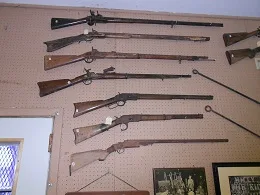
Some Excellent Sites to View Historic Carbines
During our travels we’ve come across several historic sites which in themselves have marvelous displays of frontier firearms. These include, but certainly are limited to, the sites listed below.
Fort Garland Colorado– Fort Garland was established in 1858 to protect settlers in the San Luis Valley. This old frontier fort has a large display of carbines and revolvers dating to the mid to late 1800’s. Fort Garland is located about 78 miles north of Taos New Mexico and about 90 miles southwest of Pueblo Colorado.
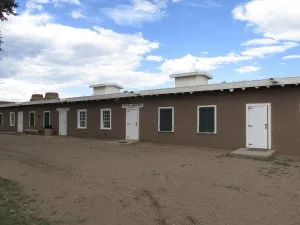
Fort Stockton Texas– This is a finely preserved western fort in southwest Texas in the town of Fort Stockton. Easy to reach via Interstate 10, Fort Stockton has a large collection of rifles and carbines used during the mid to late 1800’s. Sharps rifles and many other firearms are on display including artifacts retrieved from the fort and a lot of history regarding the buffalo soldiers who at various times were stationed there.
Fort Union New Mexico– Located just north of Las Vegas New Mexico and a few miles west of Interstate 25 and along the old Santa Fe Trail, Fort Union was an important fort protecting commerce traveling the Santa Fe Trail. Lots of artifacts and frontier rifles are on display along with the ruins of fort buildings. Fort Union also has original wagon ruts dating back to the Santa Fe Trail days. It’s a must stop if you’re traveling between Denver and Santa Fe.
Fort Sumner Museum New Mexico– Fort Sumner’s fame includes being the site where Billy the Kid is buried. The museum has a very large collection of frontier firearms as well as artifacts dating back to when the fort was operational during the mid to late 1800’s. Fort Sumner is located about 44 miles south of Santa Rosa New Mexico and Interstate 40. Fort Sumner is also about 150 miles east southeast of Albuquerque. If you’re traveling Interstate 40 between Amarillo Texas and Albuquerque it’s a great stop.
(Article and photos copyright 2013 Trips Into History)
